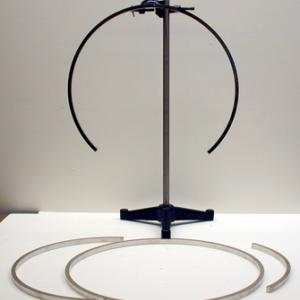College of Liberal Arts & Sciences
3A15.40 - Pendula - Arc vs. Ring
This set is designed so that all of the pieces have the same radius. When hung on the pivot and started into oscillatory motion all of these should have the same period.
- Joel David Krehbiel, "Motion of a Rocking Rainbow", TPT, Vol. 62, #3, March 2024, p. 174.
- Bill Layton, "Response to Letter in Feb. TPT", TPT, Vol. 52, # 4, April 2014, p. 197.
- Thomas A. Walkiewicz, "More Citation Exasperation", TPT, Vol. 52, # 2, Feb. 2014, p. 69.
- Nuria Rodriguez, Bill Layton, "Layton and Rodriguez Respond", TPT, Vol. 51 # 9, Dec. 2013, p. 516.
- Art Hovey, "Another Approach to the Segmented Hoop Pendulum", TPT, Vol. 51 # 9, Dec. 2013, p. 516.
- William Layton, Nuria Rodriguez, "Segmented Hoop as a Physical Pendulum", TPT, Vol. 51, # 7, Oct. 2013, p. 418.
- Thomas A. Walkiewecz and David L. Wagner, "Symmetry Properties of a Ring Pendulum", TPT, Vol. 32, # 3, March 1994, p. 142.
- George Matous and John Matolyak, "Teaching Important Procedures with Simple Experiments", TPT, Vol. 29, # 8, Nov. 1991, p. 541.
- Julius Sumner Miller, "Another Enchanting Thought", TPT, Vol. 17, # 3, Mar. 1979, p. 152.
- David L. Wagner, Thomas A. Walkiewicz, David A. Giltinan, "The Partial Ring Pendulum", AJP, Vol. 63, # 11, Nov. 1995.
- H. C. Jensen, "On the Equivalence of Truncated Ring Pendula", AJP, Vol. 35, # 10, Oct. 1967, p. 971.
- 8.5: Robert Ehrlich, "The Partial Ring Pendulum", Why Toast Lands Jelly-Side Down, p. 126-127.
- Julius Sumner Miller, "Forces and Masses", Physics Fun and Demonstrations, p. 98.
- Robert L. Wild, "Physical Pendulum - Constant Period", Low-Cost Physics Demonstrations, # 43, p. 28.
Disclaimer: These demonstrations are provided only for illustrative use by persons affiliated with The University of Iowa and only under the direction of a trained instructor or physicist. The University of Iowa is not responsible for demonstrations performed by those using their own equipment or who choose to use this reference material for their own purpose. The demonstrations included here are within the public domain and can be found in materials contained in libraries, bookstores, and through electronic sources. Performing all or any portion of any of these demonstrations, with or without revisions not depicted here entails inherent risks. These risks include, without limitation, bodily injury (and possibly death), including risks to health that may be temporary or permanent and that may exacerbate a pre-existing medical condition; and property loss or damage. Anyone performing any part of these demonstrations, even with revisions, knowingly and voluntarily assumes all risks associated with them.
